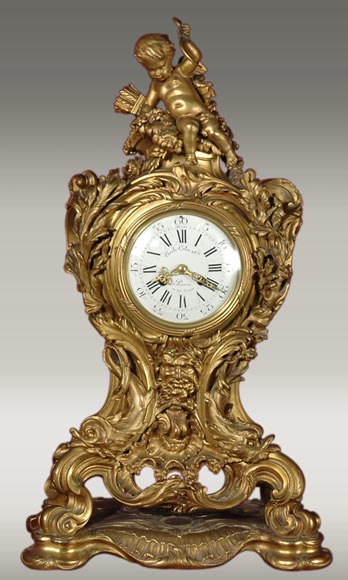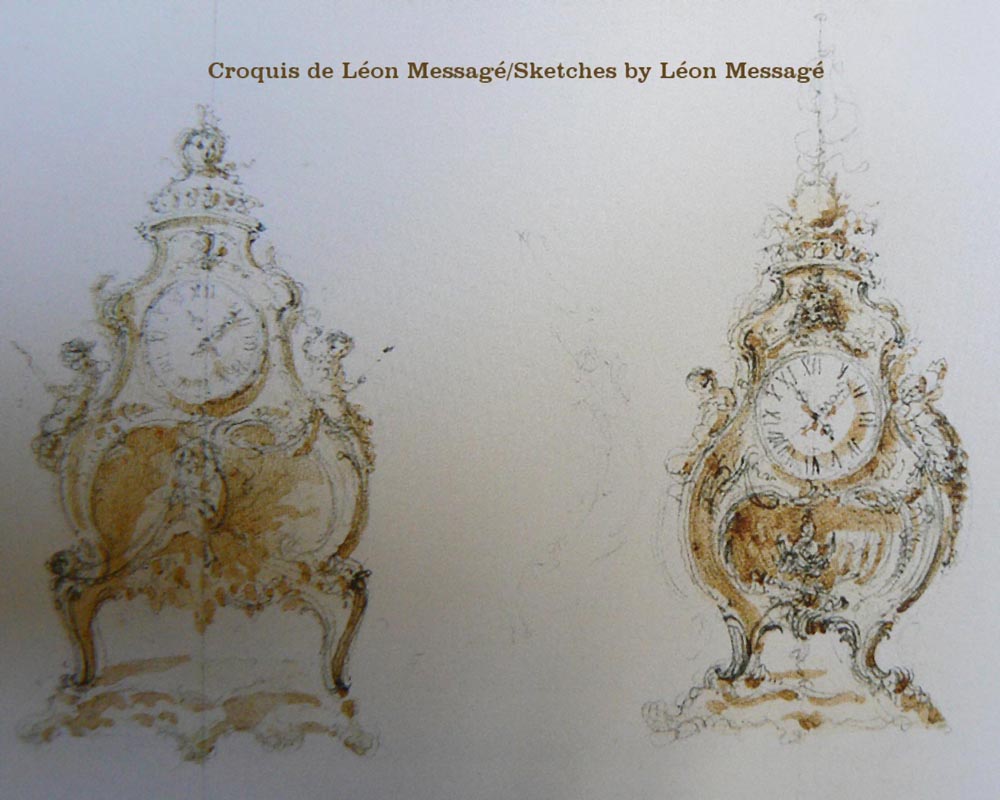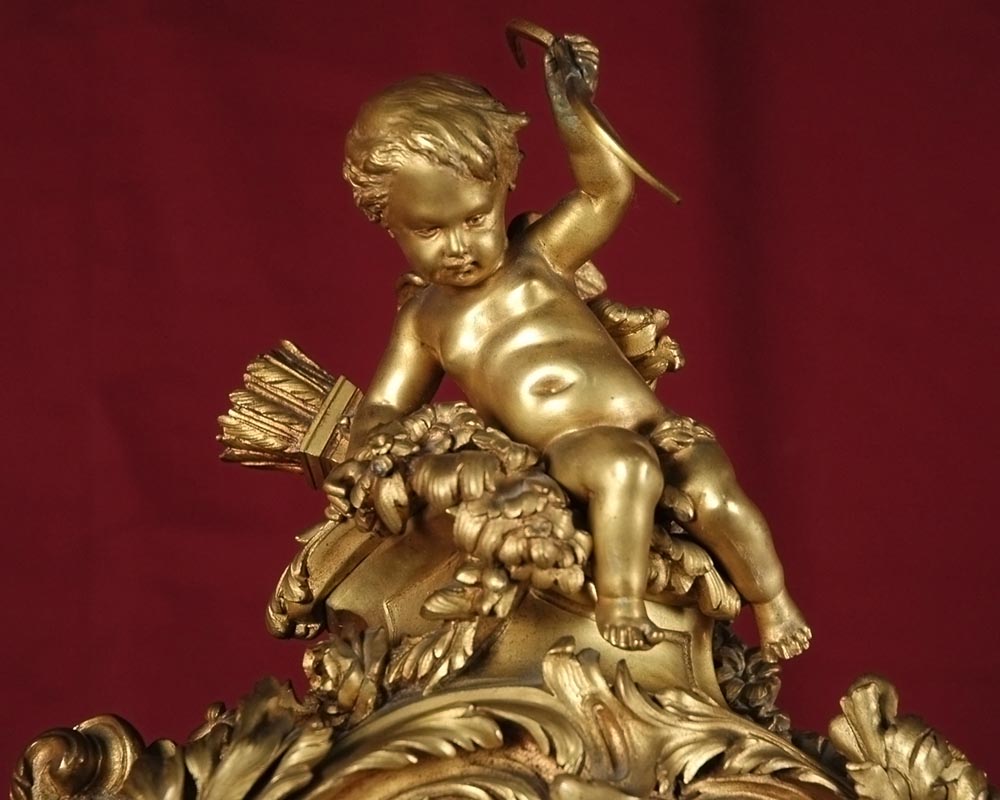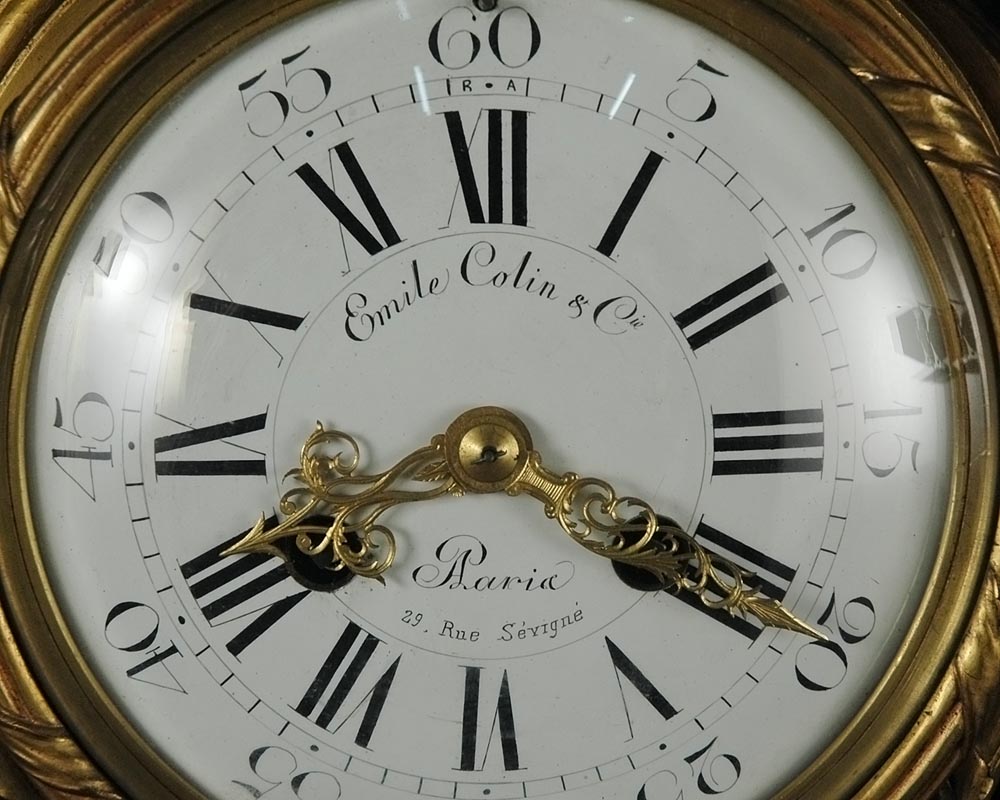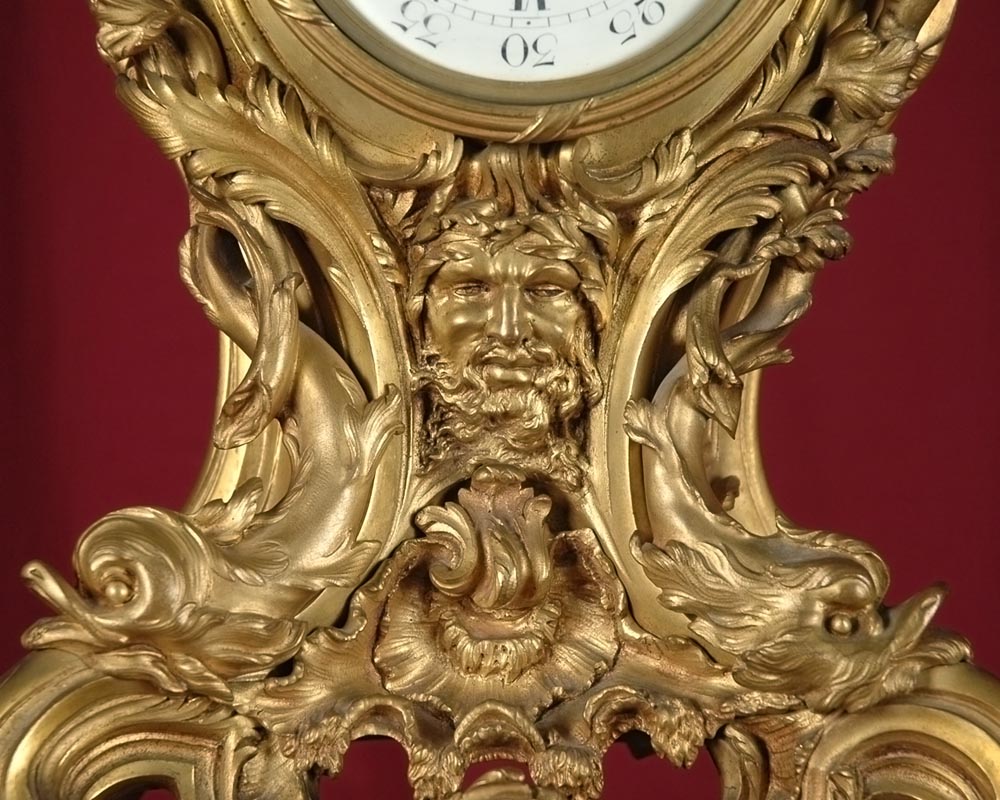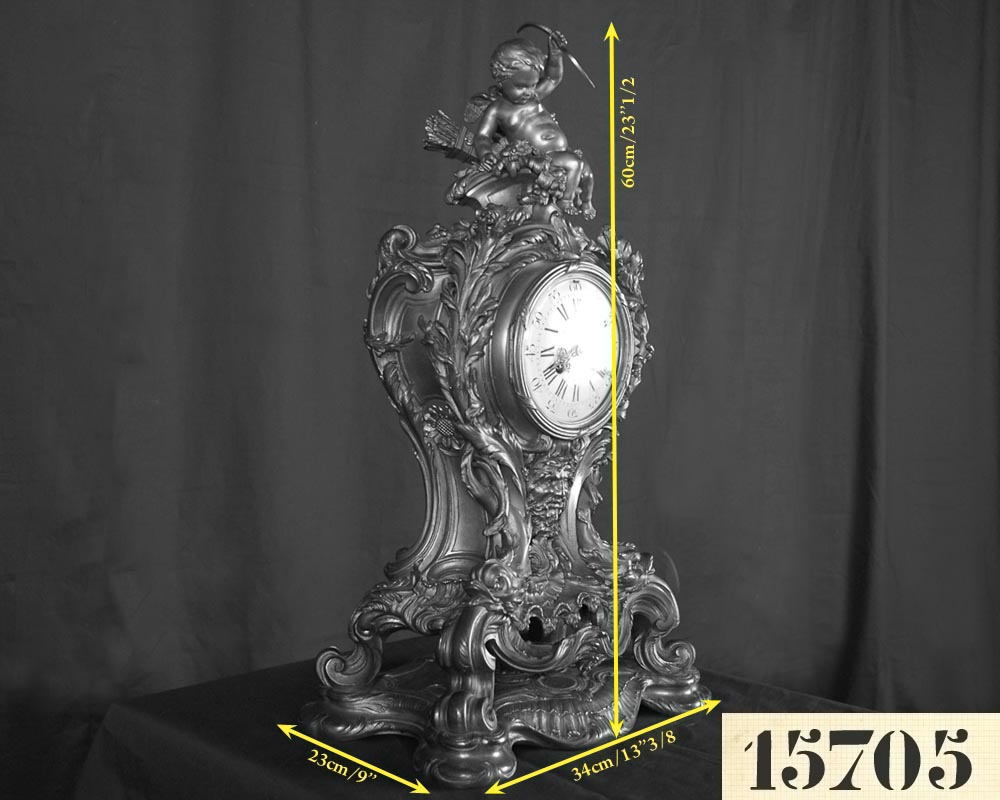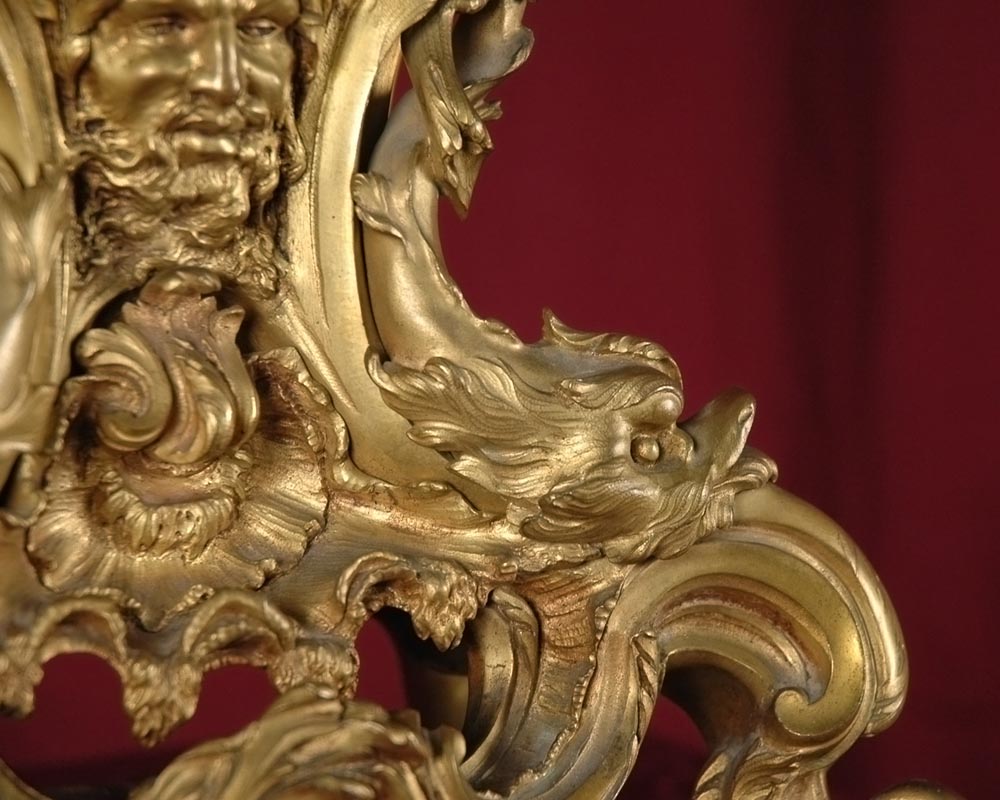Style Louis XV / Ref.15705
Léon MESSAGÉ (1842-1901) (att. to) - Clock with Cupidon
Dimensions
Width 13'' ⅜ 34cm
Height 23'' ⅝ 60cm
Depth: 9'' 23cm
Origin:
Clock face signed “Emile Colin & Co. in Paris, Rue Sévigné”.
Circa 1900
Status:
Original movement
Gilded bronze, enameled face.
This exceptional Louis XV style clock is attributed to the sculptor and decorator, Leon Message, active in the last quarter of the nineteenth century. Made of gilded bronze, this piece adopts the forms of the eighteenth century. Indeed, the arabesques, and decorative vocabulary, are characteristic of the rococo style and of a Juste-Aurele Meissonier, leader of this movement. The clock stands on four winding feet, that suppor themselves on a shelf, in the style of Louis XV decorative clocks. The decorative motifs consist of an inverted shell, foliage and coils, are also specific to the rococo style through their asymmetric treatment, the abundance and decorative character somewhat extravagant. Moreover, the term 'rococo' means, originally, artificial caves, which contained imitations of shells. The abundance of curved lines and the relatively pronounced fantasy of the ensemble are from the eighteenth century. Similarly, the rockery used a lot of grotesques, which is well illustrated here by the presence of a mask of a bearded man crowned with laurel, beneath the clock face. From both sides of this grotesque are dolphins, a motif which one often finds in the works of Léon Messagé. The clock face is surrounded by garlands of leaves lined with flowers, which bloom in the upper part of the clock, giving birth to a small horn on which sits a Cupid, holding his bow in his left hand and wearing his quiver on his back.
LÉON MESSAGÉ
(March 8, 1842 - May 16, 1901?)
Léon Messagé was born March 8, 1842 in Sens, Yonne. At 20 years old, he lived in Paris at 23 rue de Rivoli and was then referred to as 'stone carver.' Around 1885, he began collaborating with François Linke, important cabinetmaker of the Belle Epoque, providing him models for furniture and ornamental bronzes. They collaborated until the death of Messagé, who lived until the age of 58 and died May, 16 1901. It is through this collaboration with François Linke, that Messagé would be successful during the last decades of the nineteenth century. In fact, Messagé was awarded a gold medal at the 1889 World Fair and it was he who designed all the important furniture for the stand of François Linke for the Universal Exhibition in 1900. Even though he worked hard for Linke, Messagé still remained an independent craftsman, working on his own account. In his studio at 40 rue Sedaine, in the 11th arrondissement of Paris, he was the designer and creator of its models. The fundamental principle of the designs by Messagé is a light rococo, a characteristic asymmetry of rock that Parisian artisans developed in the 1720s. This clock is a good testimony of this lively design and the unique style of Leon Messagé.
Although this clock is not signed by him, there is no doubt that it was made by his hand. Indeed, in his notebook drawings and sketches Style Louis XV, published in 1890, there are two drawings of pendulums, very similar to the one presented here. ? ?Moreover, in a book on Francois Linke, a clock very similar to it is illustrated (Christopher Payne, Francois Linke 1855-1946. The Belle Epoque of French Furniture, p. 93). We find the same decorative vocabulary, the same overall composition crowned by a cherub and a similar work of sculpture.
On the dial is the signature of Emile Colin et Co, art foundry located at 29 rue Sevigne in Paris, starting in 1843. The latter has participated in numerous expositions, notably that of Chicago in 1893 where she presented a bronze clock mounted on a column of white marble. Everything was completed by a female figure made of bronze according to a work by Piat et Steiner. Like the clock, Emile Colin worked regularly for many renowned artists, such as Carrier-Belleuse Feuchère, Charpentier or Mathurin Moreau. Around 1900, we know that she was making parts based on the models of Léon Messagé, which leads us to date this clock to that time. Colin's company was also present at the Exposition Universelle in Paris in 1900.
Informations
Price: € 22 500
Recommended for you :
Dimensions:
Width: 34
Height: 60
Depth: 23
Dimensions:
Width: 35
Height: 42
Depth: 169
Dimensions:
Width: 44
Height: 48
Depth: 18
Dimensions:
Width: 32
Height: 39
Depth: 21
Dimensions:
Width: 18
Height: 33
Depth: 15
Dimensions:
Width: 31
Height: 35
Depth: 19
Dimensions:
Width: 47
Height: 76
Depth: 23
Dimensions:
Width: 30
Height: 38
Depth: 15
Dimensions:
Width: 27
Height: 44
Dimensions:
Width: 38
Height: 69
Depth: 11
Dimensions:
Width: 33
Height: 46
Depth: 17
Dimensions:
Width: 41
Height: 70
Depth: 18



